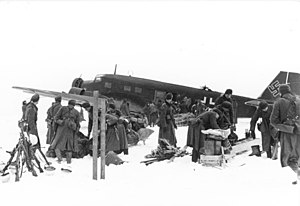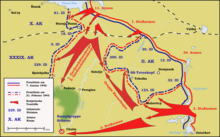Demyansk Pocket
This article includes a list of general references, but it remains largely unverified because it lacks sufficient corresponding inline citations. (October 2008) |
| Demyansk Pocket | |||||||
|---|---|---|---|---|---|---|---|
| Part of the Eastern Front of World War II | |||||||
 | |||||||
| |||||||
| Belligerents | |||||||
|
|
| ||||||
| Commanders and leaders | |||||||
|
Walter von Brockdorff-Ahlefeldt Walther von Seydlitz-Kurzbach | Pavel Kurochkin | ||||||
| Units involved | |||||||
| 16th Army | Northwestern Front | ||||||
| Strength | |||||||
|
100,000 (initially)[2][3] 31,000 (reinforcements) | 400,000 (initially) | ||||||
| Casualties and losses | |||||||
|
11,777 killed 40,000 wounded 2,739 missing 265 aircraft destroyed Total: 55,000[4] |
88,908 killed & missing 156,603 wounded Total: 245,500[5] | ||||||
 | |||||||
The Demyansk Pocket (German: Kessel von Demjansk; Russian: Демя́нский котёл) was the name given to the pocket of German troops encircled by the Red Army around Demyansk, south of Leningrad, during World War II's Eastern Front. The pocket existed mainly from 8 February to 21 April 1942.
A much smaller force was surrounded in the Kholm Pocket at the town of Kholm, about 100 km (62 mi) to the southwest. Both resulted from the German retreat after its defeat during the Battle of Moscow.
The successful defence of Demyansk was achieved by using an airbridge and was a significant development in modern warfare. Its success was a major contributor to the decision by the Army High Command to try the same tactic during the Battle of Stalingrad, but it then failed to save the Sixth Army, commanded by Paulus.
Encirclement[]
The encirclement began as the Demyansk Offensive Operation, the first phase being carried out from 7 January-20 May 1942 on the initiative of General Lieutenant Pavel Kurochkin, commander of Northwestern Front. The intention was to sever the link between the German Demyansk positions, and the Staraya Russa railway that formed the lines of communication of the German 16th Army. However, owing to the very difficult wooded and swampy terrain, and heavy snow cover, the initial advance by the Front was very modest against stubborn opposition.
On 8 January, the Rzhev–Vyazma Strategic Offensive was launched by the Red Army. This incorporated the previous Front's planning into the Toropets–Kholm Offensive Operation between 9 January and 6 February 1942 which formed the southern pincer of the attack that, beginning the second phase of the northern pincer Demyansk Offensive Operation between 7 January and 20 May, which encircled the German 16th Army's (Generaloberst Ernst Busch) II Army Corps, and parts of the X Army Corps during winter 1941/1942.
German forces inside the pocket consisted of :
- X Army Corps (General Christian Hansen)
- 30th Infantry Division (Generalleutnant Kurt von Tippelskirch)
- 290th Infantry Division (Generalleutnant Theodor von Wrede)
- SS Division Totenkopf (Obergruppenführer Theodor Eicke)
- II Army Corps (General Walter von Brockdorff-Ahlefeldt)
- 12th Infantry Division (Oberst )
- 32nd Infantry Division (Generalmajor Wilhelm Bohnstedt)
- 123rd Infantry Division (Generalmajor Erwin Rauch)
- auxiliary units
- units of Police Regiment North
- units of the Reich Labour Service
- units of organisation Todt
for a total of about 90,000 German troops and around 10,000 auxiliaries. Their commander was General Walter von Brockdorff-Ahlefeldt, commander of the II Army Corps.
Northwestern Front offensives[]

The intent of the Northwestern Front offensive was to encircle the entire northern flank of the 16th Army's forces, of which the 2nd Army Corps was only a small part, and the Soviet command was desperate to keep the Front moving even after this success. The first thrust was made by the 11th Army, 1st Shock Army and the 1st and released for the operation from Stavka reserve. A second thrust was executed on 12 February by the 3rd and 4th Shock Armies of the Kalinin Front, with the additional plan of directly attacking the encircled German forces by inserting two airborne brigades to support the advance of the 34th Army.[6] The front soon settled as the Soviet offensive petered out due to difficult terrain and bad weather.
After being assured that the pocket could be supplied with its daily requirement of 300 short tons (270 t) of supplies[2] by Luftflotte 1, Hitler ordered that the surrounded divisions hold their positions until relieved. The pocket contained two viable airfields at Demyansk and Peski capable of receiving transport aircraft. From the middle of February, the weather improved significantly, and while there was still considerable snow on the ground at this time, resupply operations were generally very successful due to inactivity of the VVS in the area.[2] However, the operation did use up all of Luftflotte 1's transport capability, as well as elements of its bomber force.
Over the winter and spring, the Northwestern Front launched a number of attacks on the "Ramushevo corridor" that formed the tenuous link between Demyansk and Staraya Russa but was unable to reduce the pocket.
Breakout[]
On 21 March 1942, German forces under the command of General Walther von Seydlitz-Kurzbach attempted to manoeuvre through the "Ramushevo corridor". Soviet resistance on the Lovat River delayed II Corps' attack until April 14. Over the next several weeks, this corridor was widened. A battle group was able to break the siege on 22 April, but the fighting had taken a heavy toll.[7] Out of the approximately 100,000 men originally in the pocket, there were 3,335 lost and over 10,000 wounded.

Between the forming of the pocket in early February and the relief of Demyansk in May, the two pockets (including Kholm) received 65,000 short tons (59,000 t) of supplies (both through ground and aerial delivery), 31,000 replacement troops, and 36,000 wounded were evacuated. The supplies were delivered through over 100 flights of Junkers Ju 52 transport aircraft per day.[3] The cost was significant: the Luftwaffe lost 265 aircraft, including 106 Junkers Ju 52, 17 Heinkel He 111 and two Junkers Ju 86 aircraft. In addition, 387 airmen were lost.[8] Richard Overy argues that the Demyansk airlift was a Pyrrhic victory, citing the loss of over 200 aircraft and their crew "when annual production of transports was running at only 500; and all to save 90,000 German soldiers, 64,000 of whom were either killed, wounded or too sick for service" by the airlift's end.[9]
Fighting in the area continued until 28 February 1943. The Soviet forces did not retake Demyansk until 1 March 1943, with the organized withdrawal of the German troops.
Effect of the Demyansk airlift operation[]
The success of the Luftwaffe convinced Reich Marschall Hermann Göring and Hitler that they could conduct effective airlift operations on the Eastern front.[8] Furthermore, it "determined Hitler in his belief that encircled troops should automatically hold on to their territory.[10]
After the German 6th Army was encircled in the Battle of Stalingrad, Göring convinced Hitler to resupply the besieged forces by airlift until a relief effort could reach them;[11] however, the sheer scale of the effort required in Stalingrad (calculated at 750 tons per day) greatly exceeded the Luftwaffe's now-depleted capacities.[12] The Stalingrad airlift effort ultimately failed to deliver sufficient supplies, and the Germans estimated that they lost 488 transports, as well as 1,000 personnel, to the now-strengthened Soviet Air Forces.[13] Despite the Stalingrad airlift, the German 6th Army, counting 300,000 soldiers trapped in the city, had to surrender in February 1943, due to their degrading physical condition, as the supplies with food, new troops, weapons and ammunition was not sufficient to defeat the Soviet troops at Stalingrad. At the time of the surrender, the German 6th Army lost 100,000 soldiers at Stalingrad, counting from November 1942 until February 1943.
References[]
- ^ Glantz 2001, p. 31.
- ^ Jump up to: a b c Hayward 1997, p. 24.
- ^ Jump up to: a b Beevor 1999, p. 43.
- ^ "OKH Casualty Data December 1942". Archived from the original on 2015-12-28. Retrieved 2015-03-24.
- ^ "Г.Ф.Кривошеев (под редакцией). Россия и СССР в войнах XX века: Потери вооруженных сил". Lib.ru. Retrieved 2017-06-23.
- ^ Rutherford 2008, p. 359.
- ^ Rutherford 2008, p. 365.
- ^ Jump up to: a b Bergstrom 2007, p. 23.
- ^ Overy 1980, p. 414.
- ^ Beevor 1999, pp. 43–44.
- ^ Beevor 2012, p. 286.
- ^ Hayward 1997, pp. 24–26.
- ^ Beevor 1999, pp. 292, 398.
Sources[]
- Beevor, Antony (1999). Stalingrad. London: Penguin Books. ISBN 9780140249859.
- Beevor, Antony (2012). The Second World War. New York: Back Bay Books. ISBN 978-0-316-02374-0.
- Bergstrom, Christer (2007). Stalingrad: The Air Battle: 1942-January 1943. London: Chevron/Ian Allan. ISBN 978-1-85780-276-4.
- Сборник. На Северо-Западном фронте — М.: «Наука», 1969 (Вторая Мировая война в исследованиях, воспоминаниях, документах) Институт военной истории Министерства Обороны СССР; под редакцией и с предисловием члена-корреспондента АН СССР генерал-лейтенанта П. А. Жилина; cоставил и подготовил сборник кандидат военных наук, доцент, полковник Ф. Н. Утенков; научно-техническая работа проведена подполковником В. С. Кислинским.
- Glantz, David (October 1992). "The Ghosts of Demiansk: In Memory of the Soldiers of the Soviet 1st Airborne Corps". Journal of Military History. 56 (4): 617–650. doi:10.2307/1986164. JSTOR 1986164.
- Glantz, David (2001). "The Soviet-German War 1941-1945: Myths and Realities: A Survey Essay". Strom Thurmond Institute. Archived from the original on 22 July 2017. Retrieved 2 May 2016.
- Group of authors, A collection. On the North-Western Front, Moscow, Science (pub.), 1969 (Second World War in research, memoirs, documents), Institute of military history of Ministry of Defence of USSR, edited and with foreword by member-correspondent AN SSR, General-lieutenant P.A. Zhilin; compiled and prepared for publication by candidate of military sciences, dozent, Colonel F.N. Utenkov, scientific-technical work undertaken by Sub-colonel V.S. Kislinsky.
- Hayward, Joel (Spring 1997). "Stalingrad: An Examination of Hitler's Decision to Airlift" (PDF). Airpower Journal. 11 (1): 21–37.
- Overy, Richard (July 1980). "Hitler and Air Strategy". Journal of Contemporary History. 15 (3): 405–421. JSTOR 260411.
- Rutherford, Jeff (2008). "Life and Death in the Demiansk Pocket: The 123rd Infantry Division in Combat and Occupation". Central European History. 41 (3). doi:10.1017/S0008938908000551. JSTOR 20457366.
- Conflicts in 1942
- Military operations of World War II involving Germany
- Battles and operations of the Soviet–German War
- Encirclements in World War II
- History of Novgorod Oblast
- Airbridge (logistics)
